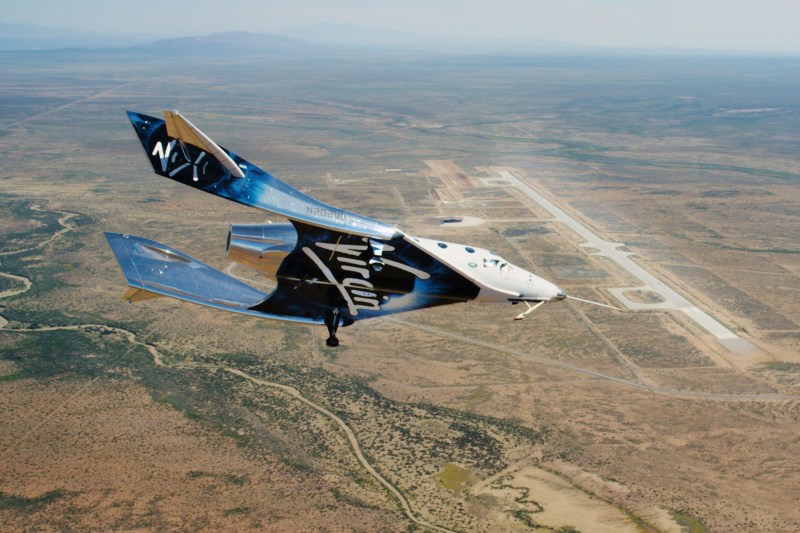Featured image credit: Virgin Galactic
Lift Off Time/Launch Window | May 22, 2021 – TBD (subject to weather) |
|---|---|
Mission Name | Test Flight (probably PF05) |
Launch Provider | Virgin Galactic |
Customer | Virgin Galactic |
Rocket | VSS Unity / SpaceShipTwo |
Launch Location | Spaceport America, Jornada del Muerto, New Mexico |
Payload mass | N/A |
Where is the spacecraft going? | Up to the edge of space* and back down again (* The USA considers space to start at 50 miles (80 km) altitude; the rest of the world considers space to start at the Kármán line – 100 km) |
Will they be attempting to recover the first stage? | Yes (White Knight Two launch aircraft VSS Eve will be recovered) |
Where will the first stage land? | Spaceport America, New Mexico |
Will they be attempting to recover the fairings? | SpaceShipTwo does not have fairings |
Are these fairings new? | SpaceShipTwo does not have fairings |
How’s the weather looking? | N/A |
This will be the: | – 20th flight of VSS Unity* – 5th powered flight of VSS Unity – 56th flight of a SpaceShipTwo vehicle – 1st flight for Virgin Galactic in 2021 – 2nd flight of any Virgin company rocket in 2021 (* December 21, 2020 VSS Unity was not released from the mothership VMS Eve / White Knight Two) |
Where to watch | Official livestream (if available) |
What does all this mean?
Virgin Galactic is about to undertake the next powered flight of its sub-orbital, reusable rocket SpaceShipTwo. SpaceShipTwo offers passengers access to sub-orbital space and micro-gravity. It will launch from under the body of its carrier craft, White Knight Two, at an altitude of around 15,000 m (50,000 ft).
What is SpaceShipTwo?
SpaceShipTwo is a design of a rocket powered spaceplane that launches from under the wing of a carrier aircraft. It uses a hybrid rocket engine to boost itself up to beyond the edge of space (depending on your definition of “space”) to give paying passengers a few minutes of weightlessness.
This flight was originally intended to take place in February, but was delayed due to maintenance issues on VSS Eve, the carrier aircraft. A post-flight inspection in early May led to further maintenance on the tail of the aircraft. Virgin has now assessed that the vehicle is ready for this mission.
SpaceShipTwo is not yet ready to carry paying passengers, and is still very much in the test phase of operations. VSS Unity is the second SpaceShipTwo vehicle. The previous vehicle, VSS Enterprise, crashed in 2014 in an accident which killed the co-pilot Michael Alsbury. The pilot, Peter Siebold, also suffered severe injuries in the accident. That flight was from Mojave Air and Space Port, California, before Virgin Galactic moved its operations to New Mexico. An investigation found that the crash occurred when the tail section accidentally moved into the tethered position during powered ascent.
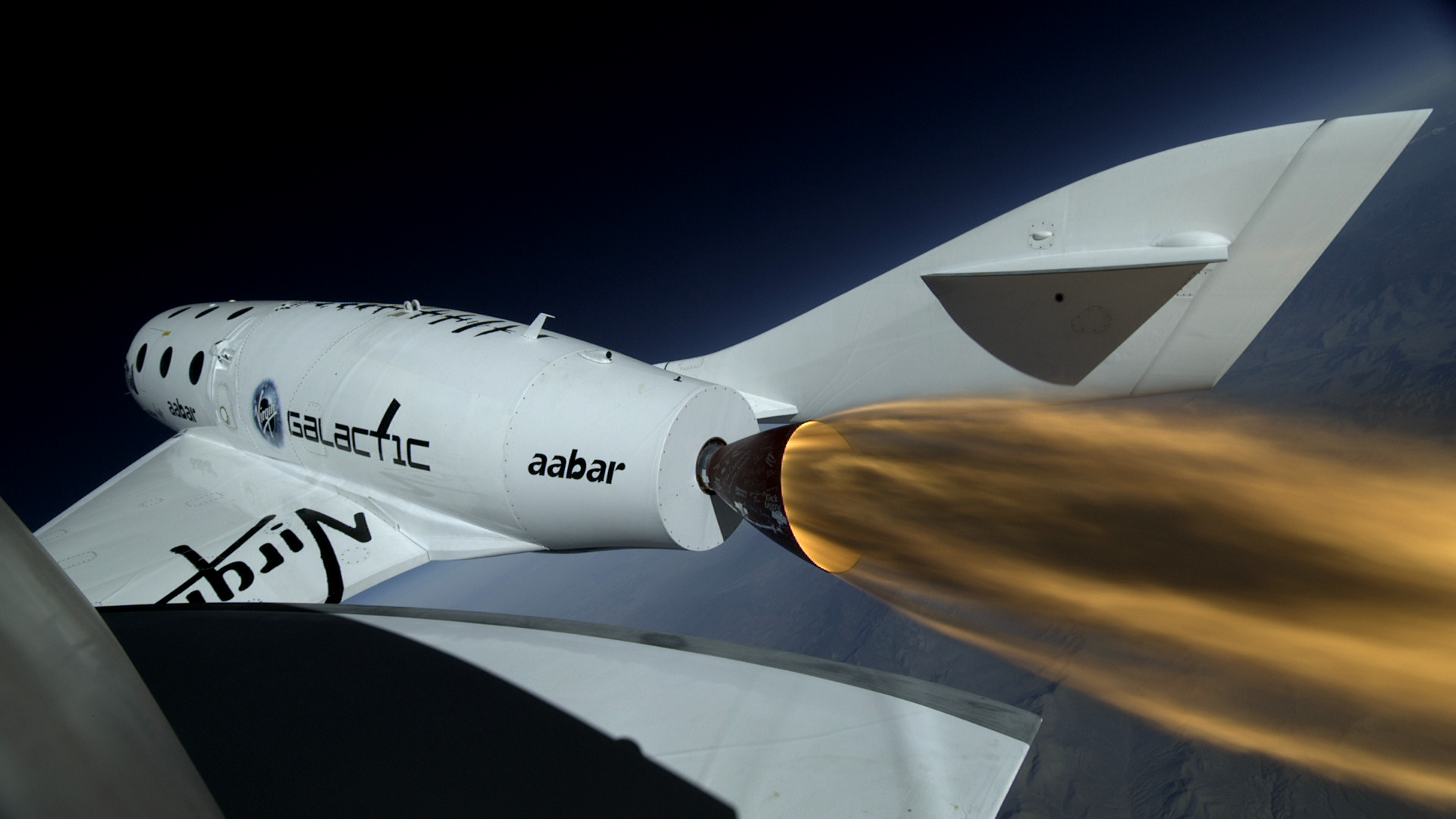
SpaceShipTwo and its mothercraft, White Knight Two, were designed and built by The Spaceship Company, formed by Burt Rutan and Sir Richard Branson in 2005. Burt Rutan’s pre-existing company, Scaled Composites, previously built and flew SpaceShipOne (more on that later).
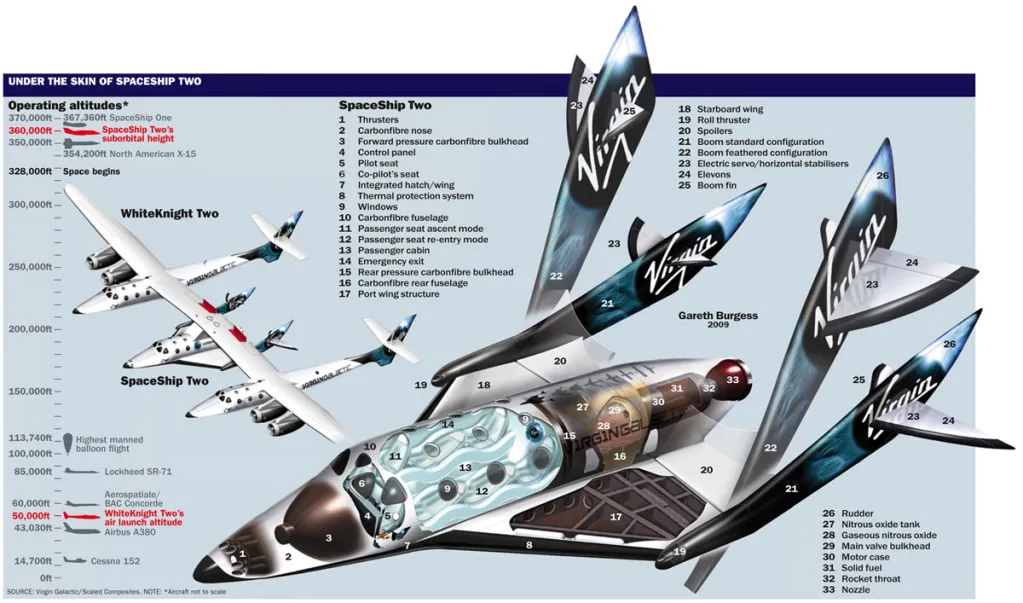
SpaceShipTwo is designed to fly with two flight crew and six passengers. It uses its onboard rocket motor for powered ascent following separation from White Knight Two. On reaching apogee, it deploys a special feathered tail section in order to gain the proper nose-down attitude prior to reentry. A failure to secure this tethering section in 2014 led to the fatal crash of VSS Enterprise.
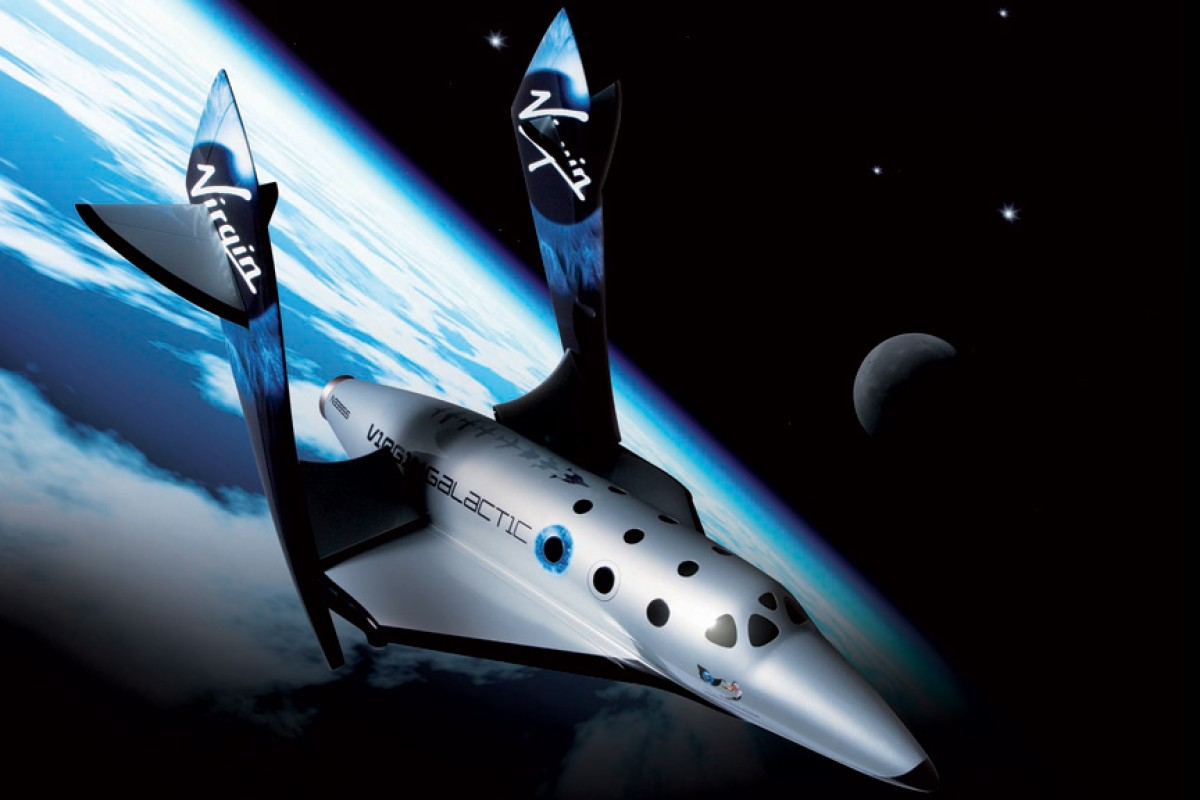
SpaceShipTwo’s rocket motor
SpaceShipTwo originally used a hybrid motor developed by Sierra Nevada Corporation. This engine used hydroxyl-terminated polybutadiene (HTPB) as fuel and nitrous oxide (N20) as oxidizer. A hybrid engine is one in which the fuel and oxidiser exist in different phases of matter. In this case, the fuel is solid, and the oxidiser is stored as liquid and consumed as a gas.
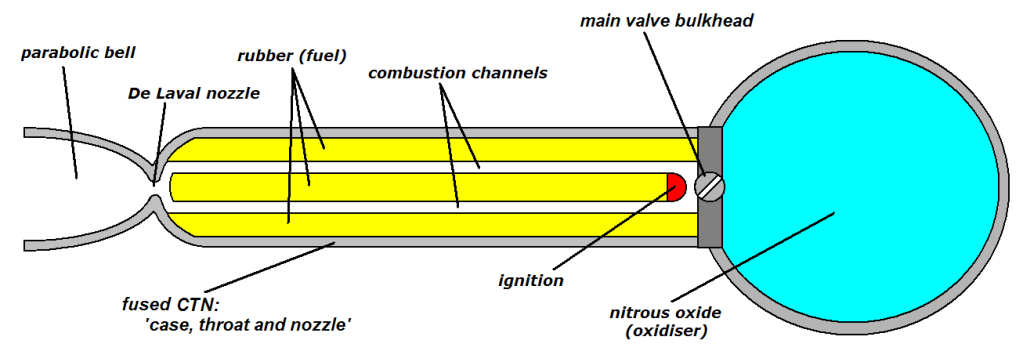
Around the time of the crash of VSS Enterprise, Virgin Galactic experimented with changing the engine design to run on a polyamide plastic fuel instead of HTPB. Since then, however, Virgin has switched back to using HTPB again, but now produces the current RocketMotorTwo engines in house instead of buying them from SNC.
Who is Burt Rutan and what is Scaled Composites?
Elbert “Burt” Leander Rutan is the founder of the notable aerospace company Scaled Composites. He graduated from California Polytechnic Institute in 1965 with a degree in Aeronautical Engineering. His first company, Rutan Aircraft Factory, was in operation from 1974 to 1985, designing and selling plans for novel aircraft. This was in Kansas.
In 1982, he founded Scaled Composites as a research company in Mojave, California. Since its creation Scaled Composites has designed over 16 different known aircraft designs.
In its early years, the company became famous for building the one-of-a-kind Voyager aircraft. Rutan planned an aircraft that could fly around the entire planet non-stop without landing or in-flight refuelling. In 1986, Burt’s brother Dick Rutan and fellow aviator Jeana Yeager (no relation to Chuck Yeager) successfully flew Voyager around the planet over the course of 9 days.
What is White Knight Two?
White Knight Two is the carrier aircraft that takes SpaceShipTwo up from local ground level to an altitude above mean sea level of 15,000 m (50,000 ft). The carrier aircraft then releases SpaceShipTwo which begins its own powered flight seconds later.
White Knight Two then returns to land under normal jet engine power, as during its ascent. The aircraft has four Pratt & Whitney PW308 engines and two fuselages. Each engine provides 30.7 kN (6,900 lbf) of thrust. One fuselage holds the active cockpit for control of the aircraft, while the other fuselage is a direct copy of SpaceShipTwo. This is so that White Knight Two can be used for training crew and passengers on what to expect for their flights on board SpaceShipTwo.

The first White Knight Two vehicle, VMS Eve, flew for the first time in 2008. It has a flight crew of two people, plus additional people to take part in the deployment of the spacecraft, and those undergoing training for SpaceShipTwo.
White Knight Two has an impressive service ceiling of 21,000 m (70,000 ft), based on a relatively large wingspan of 43 m (141 ft).
Stratolaunch
Stratolaunch, the aircraft with the largest wingspan that has ever flown, bears notably similar characteristics to White Knight Two. This is not a coincidence, since Scaled Composites, the same company that designed and flew White Knight One in support of SpaceShipOne, also built Stratolaunch.
The purpose of Stratolaunch (the vehicle and the company) is to launch orbital-class rockets from under the wing of an aircraft flying at around 11,000 m (35,000 ft). This is a similar concept to Virgin Orbit’s LauncherOne rocket, but at a larger scale.
The Stratolaunch aircraft first took to the air on April 13, 2019, for a flight of 2 hours 29 minutes duration, reaching an altitude of 5,200 m (17,000 ft).

What was SpaceShipOne?
SpaceShipTwo is at heart a scaled-up version of SpaceShipOne, its direct precursor. The previous vehicle, SpaceShipOne, was the first craft of any type to fly to the edge of space and return to ground twice within a two-week window. Burt Rutan’s company, Scaled Composites, designed and built SpaceShipOne.
Winner of the X-Prize, SpaceShipOne now hangs in the Smithsonian Air and Space Museum on the National Mall in Washington, DC.

White Knight One, alternatively Model 318 White Knight, also built by Scaled Composites, carried SpaceShipOne to deployment altitude. White Knight One flew with SpaceShipOne attached underneath for a total of 17 flights during 2003 and 2004. After SpaceShipOne met the requirements for winning the X prize, neither craft flew again.
What was the Ansari X Prize?
Originally called simply the X Prize, and created by the X Prize Foundation, this was a non-profit challenge and competition for private companies to build a reusable spacecraft that could achieve sub-orbital flight.
After gaining significant financial backing from Iranian-American entrepreneurs Anousheh and Amir Ansari in 2004, the name changed to the Ansari X Prize. (Anousheh Ansari later flew to the International Space Station on a Soyuz capsule, becoming only the 4th “space tourist” to visit the ISS.)

Announcement of the X Prize took place in 1996. Inspiration for it came from the earlier 1919 Orteig Prize that led to Charles Lindbergh’s first solo crossing of the Atlantic in the Spirit Of St Louis in 1927. (British aviators John Alcock and Arthur Brown made the first non-stop transatlantic flight in 1919, however, in a modified Vickers Vimy. The first return transatlantic flight was also in 1919, using the R34 rigid airship.)
The challenge of the X Prize was to build and demonstrate a craft that could reach the international edge of space, the Kármán line at 100 km, twice within a 14 day timespan. 26 teams attempted to meet this goal in some shape and form. Scaled Composites won the prize on October 4, 2004 with their second 100 km flight, after performing the first of the two required flights on September 29, 2004.





